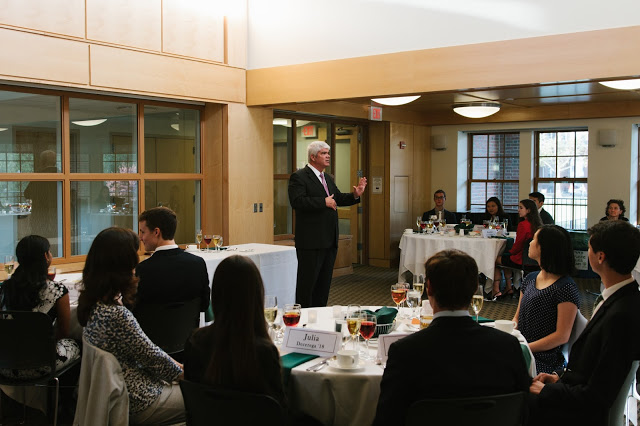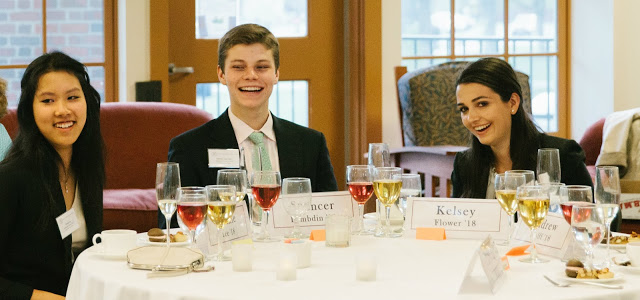- Public Policy
- Leadership
- Funding
- News & Events
- About the Center
Back to Top Nav
Back to Top Nav
Back to Top Nav
Back to Top Nav
During the second session of Civic Skills Training, the First-Year Fellows learned the etiquette of networking and business dinners. With occasional background information on the history of certain etiquettes, Shutt guided the fellows through the dinner and answered questions that fellows had on dining etiquette.
The session started off with a networking session, in which fellows mingled with other fellows and the Rockefeller Center staff. The fellows learned about where to put their name tags in a reception (upper right chest, so that other people can see their name and organization after a handshake), and whether or not to eat a particularly smelly snack served to them. Prawns were served during the networking session, and a fellow asked whether they should eat one as prawns would most definitely make their breath smell -- Shutt replied that the primary purpose of the reception was to mingle and meet new people, and if eating the prawn seemed like a bad idea in mingling with people, the fellow should not eat the prawn. Shutt offered further guidance on the topics of networking conversations - something to spark interest, but a topic that would not upset anyone. Shutt gave an example of a train crash that had happened the same day; it would most certainly spark interest, and many would find it interesting, but it was an unsuitable topic as it may upset others. A more suitable topic would be to discuss what others were doing in their jobs.
 |
| Robert Shutt guides the fellows through the basics of networking etiquette. Photo by Hung Nguyen '18. |
For the dinner following the networking session, the fellows sat in groups of four or five at a table with a Rockefeller center staff. Starting with the soup, Shutt guided the fellows through dining etiquette: i.e. when eating a soup, one should spoon away and then draw the spoon back, to avoid spilling any on the table. Shutt also provided mnemonics on how to remember where everything was on the table: forming an 'o' with both hands, one can see that the bread (that starts with a 'b') is on the left, and the drinks (that starts with a 'd') is on the right. Opinions differ on where to place the fork and the knife after finishing the entrée: Shutt suggested the two o'clock direction, placing the knife and the fork about 30 degrees away from the middle of the plate, to make it easier for waiters to take the plate. Shutt continued to answer questions from the fellows: what should one do when offered food that was not ordered? He explained that in the example of the soup, which the fellows did not select, the fellows could have simply said 'no thanks' when it was offered.
 |
| Photo by Hung Nguyen '18. |
Shutt made it clear throughout the session that the most important component of dinner etiquette was not where to place the fork or the knife, but consideration for others. The person closest to the bread basket or the butter tray should be the first one to offer it to others. When leaving the table for a short time, one should make other contact with at least another person and leave the napkin on the chair. And when leaving the napkin behind on the table after the dinner, it should be clean as possible, so the host would be able to use it again the following evening without using a new napkin. Courtesy demonstrates consideration for others, and Shutt explained it to the fellows with precise instructions and humor during the session.
-Written by Jinmyoung Lee '16, Rockefeller Center Student Program Assistant